The most important strike in American labor history, historians agree, began at the end of 1936. The feisty young United Auto Workers launched the first of a series of sit-down strikes against General Motors at Fisher Body Plant No. 1 in Flint.
The feisty young United Auto Workers launched the first of a series of sit-down strikes against General Motors at Fisher Body Plant No. 1 in Flint. The goals were to earn recognition for the UAW as the bargaining agent for GM workers, and to make the company stop shipping work to plants with nonunion workers. The strike lasted 44 days and became the first of many union victories.
The UAW was formed in 1935 by union activists dissatisfied that the auto union under the AFL had not been allowed to name its own leaders. Homer Martin was elected president, and Walter and Victor Reuther and George Addes were officers. The Reuther brothers, originally from Wheeling, W. Va., had come to Detroit in 1927 to find work in the auto industry and soon became active in the union movement.
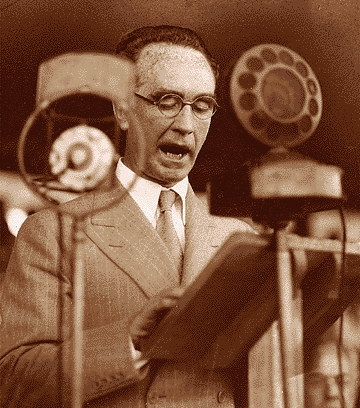
Gov. Frank Murphy ordered 4,000 National Guardsmen to the Flint plants, but would not give orders to use force against the workers.
|
On Nov. 18, 1936, the UAW struck a Fisher Body plant in Altanta. On Dec. 16, they hit two GM plants in Kansas City, and on Dec. 28, a Fisher stamping plant in Cleveland. Two days later they struck Fisher Body No. 1 in Flint. Within two weeks, approximately 135,000 men from plants in 35 cities in 14 states were striking General Motors.
As the nation was emerging from the Great Depression, the striking workers enjoyed the sympathy of most of the people, including Michigan governor Frank Murphy and popular New Deal President Franklin Delano Roosvelt. Roosevelt had promised in his inaugural speech to drive out the "economic royalists," a pointed reference to the General Motors officials.
Those against the upstart union included Al Sloan, the GM president, and his comrade, the opinionated Henry Ford, who felt more sympathy for his competitor than for workers. Ford, however, refused to shut down his plants in sympathy for GM. Of course, the stockholders sided with their profit maker. And one Gallup poll revealed that 53 percent of those polled sided with the company.
But GM vice-president William S. Knudsen, despite being on the management side, felt that collective bargaining's time had come.
Before the Depression there were 470,000 auto workers. The number fell by half, as did the wages, which had been reduced from $40 per week to about $20. Because these harsh times still haunted the workers, job security was an important issue. Another bone of contention was the hated "spies" informing on union members. The workers could be fired by any foreman anytime. The work itself -- dangerous, difficult, and boring -- caused many injuries, often for simple reasons such as lack of gloves. Exertion caused the families extreme exhaustion, which distressed the workers' families, who shared the fear of possible job loss. Could the worker endure? They needed the money. The rock and the hard place squeezed them all.
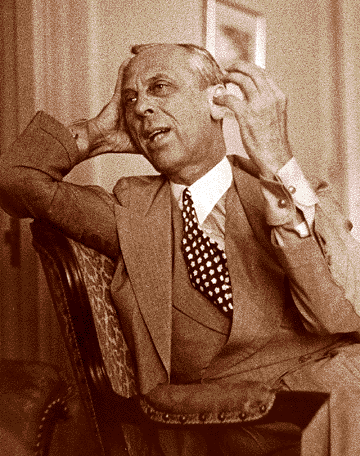
Alfred P. Sloan Jr., president of General Motors, considered his workers to be among the most "pampered" in the industry.
|
The company, dubbed "Generous Motors" by many who wished for jobs with the prosperous firm, was caught off guard by the strike, because it considered its workers to be among the most "pampered" in the industry. GM had just given workers a Christmas bonus of $47 from its "GM Appreciation Fund." The union seemed to have ignored the "GM Layoff Benefit Plan" and the "Income Security Plan" offered by the company in 1936. Both plans emerged much later as the SUB pay union plan.
The Flint sit-down strike began the evening of Dec. 30, 1936, when the night shift stopped the loading of dies being shipped by the company to places where unionism was weaker. The union had noticed that the sit-down method of protest, which had started in Europe, seemed to work successfully. So the workers sat down and locked themselves in, trying to protect their jobs from being removed.
The charasmatic, aggressive young Walter Reuther became the workers' champion, and he won their hearts. He did not fear violence, nor did his brothers Victor and Roy. Biographers of the future UAW president would call him the "crown prince of labor" and "the most dangerous man in Detroit."
On Jan. 3, 1937, The Detroit News reported that Knudsen said: "A meeting between the management and the union was scheduled for Monday, Jan. 4, but on Wednesday, before that meeting could take place, the second shift sat down and caused the plant to close, throwing out of work 7,000 men. More than 1,000 are still in the plant." Nearly all 7,000 plant workers were union members.
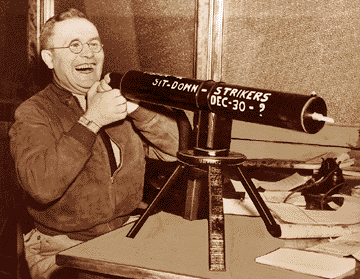
Retired Major Henry A. Geerds examines a model of a machine gun made by strikers at the Fisher Body Plant no. 2 in Flint.
|
The News gave the union version: "Flint Fisher Body Plant No.1 sat down at 10 p.m. Wednesday because the company was reported moving dies from the plant to Grand Rapids and Pontiac, which the union contends amounted to breaking faith."
The union called for supporters to gather at Cadillac Square in Detroit as a show of strength. The overflowing crowd of 150,000 supporters surprised even the union sympathizers and gave the union the self-confidence they needed to show its power and solidarity over its management "oppressors." Other union workers joined in sympathy strikes, closing plants in other states.
Among the plants closed by a sit-down strike was Fisher No. 2, also in Flint. The company responded by turning off the heat, and the cold winter caused the strikers there to compare themselves to George Washington and his men at Valley Forge.
Then, on Jan. 11, 1937, the police tried to stop food delivery. A riot ensued.
"The rioting at Flint resulted in injury to 16 strikers and spectators and 11 officers," The Detroit News reported. "The condition of one striker was reported to be critical. Most of the strikers were injured by buckshot fired from riot guns by the Flint police. The officers were injured principally by missiles thrown from the plant by the stay-in strikers.
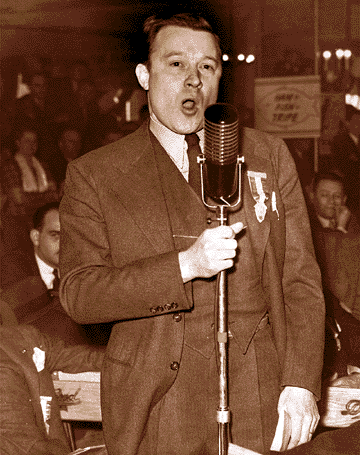
Walter Reuther, future president of the UAW, was one of the leaders of the Flint strikes.
|
"A pitched battle raged at the gates of the plant for 20 minutes, with 30 to 40 policemen opposing several hundred enraged strikers. The strikers pelted the officers with iron nuts, bolts and milk bottles and spurted thick streams of water on them from fire hoses. The police retaliated with tear gas and riot guns."
Biographer Nelson Lichtenstein tells of the Reuther brothers' role in the incident: "Roy and Walter were in the thick of the twilight battle, but Victor proved the real hero. For hours he manned the UAW sound car, from which he poured forth a constant stream of encouragement and tactical guidance described by one observer as 'an inexhaustible furious flood pouring courage into the men.'"
Twice the attacking police were repulsed. The winds had shifted and sent the tear gas back on the officers, who were then pelted with metal hinges thrown by the strikers. A crowd of sympathizers protected the strikers and the police retreated.
"The battle ended with the strikers in complete control of the gates," The News continued. "A crowd of nearly 2,000 watched the struggle. The plant lies in a valley, on the north side of the Flint River. The onlookers stood on both slopes of the valley, well out of harm's way. There was little to be seen from these points of vantage. The clouds of tear gas obscured the batttlefield.
"After the fighting had subsided, the crowd grew to about 5,000. They stood there most of the night, awaiting new developments which did not come."
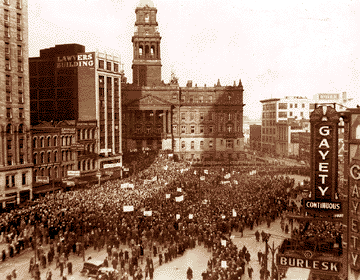
A United Auto Workers rally in Detroit's Cadillac Square drew Ê 150,000 supporters.
|
News of the riot, dubbed "the Battle of the Running Bulls," reached Gov. Frank Murphy in Lansing before midnight. Before he left by auto for the riot site, he said, "It won't happen again ... Peace and order will prevail. The people of Flint are not going to be terrorized. The State of Michigan will be supreme."
However, despite his mobilizing 4,000 National Guardsmen, Murphy refused to use them against the workers. The besieged sit-downers held. They continued to warm themselves with barrels of burning coke. Wives and others sympathizers brought food and news to the windows.
Inside, they formed different groups such as guards, cleaners, news gatherers and food handlers. Others played cards, while some played musical instruments smuggled in, undoubtedly singing union folk songs.
Paralysis of the Chevrolet and Fisher Body division plants in Flint developed as the union's foremost objective. The future of the union depended on its ability to keep these key units of GM out of production.
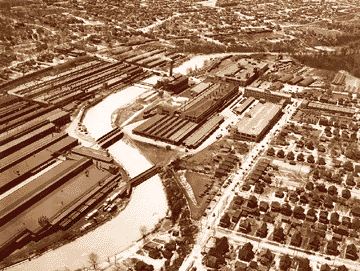
A 1930 aerial view of the Chevrolet plants in Flint. Ê Ê Ê Paralysis of the Chevrolet and Fisher Body division plants in Flint - key units in the production of GM parts - was the union's prime objective in 1937.
|
GM had rejected flatly all of the union's demands early in January, 1937. The corporation tried to push a back-to-work movement and sought federal assistance to sweep the sit-down strikers out of its plants.
On Jan. 29, GM went to court to request an injunction ordering the strikers out. The judge, Edward Black of Genesee County, owned $150,000 of GM stock and his order was derided by laughter. It only caused more union reinforcements to pour into Flint.
Other than "the Battle of the Running Bulls," only one other violent incident was reported during the sit-down strikes, on Feb. 1, when some 28 persons were injured. Striker Earl DeLong, 22, shot in the stomach, was the most seriously hurt.
The Feb. 1 riot happened at Chevrolet plant No. 4 in Flint, when the union tried to encourage the 6,000 day shift workers to join the sit-down strike. Five hundred union men entered the plant to protest "discrimination against union members." The News reported that the union men began breaking factory windows. Tear gas and missiles were thrown, but no shooting was reported. Roy Reuther and Powers Hapgood manned the sound truck. The plant, a few blocks from the Fisher Body plant, had resumed work a week earlier because the workers decided to go back.
The News gave this account: "The guardsmen forming a line around the No. 4 plant were part of a contingent of 1,200 who formed a bayoneted ring of steel around the 80-acre grounds which house all 12 plants of the Chevrolet Motor Car Co. at Flint. Machine guns emplacements were at strategic approaches and except for a small group of pickets outside the gates of the No. 4 plant, all visitors were barred unless they had special military passes.
"The guardsmen surrounded the grounds and 'enforced peace' on orders of Gov. Murphy, following the rioting."
The News also gave the union version: "Then company police and hundreds of thugs, armed with tear gas pistols, tear gas bombs, blackjacks and clubs manufactured in the Chevrolet woodshop, attacked all workers in the plant, using floods of tear gas. It was a clear case, apparently, of company thugs against the workers since all the injured workers were found in the plants and no one was injured on the outside of the company property. City police do not seem to have been involved."
The National Guard fixed bayonets and halted any delivery of food to the occupiers. But the governor never ordered the troops into action.
The strikers vowed a hunger strike until their families could bring them food, or their demands were met. The sit-downers appealed to the governor.
President Roosevelt asked GM to meet with the union once more. The tension subsided. General Motors signed an agreement with the UAW, giving the union bargaining rights in 17 GM plants shut by sit-downs.
Employees at the 17 plants involved got 5 percent pay hikes and were allowed to speak in the lunchroom. The company agreed not to discriminate against union members and agreed to begin negotiations on other matters.
A synopsis of the issues included in the union demands:
- Recognition of UAW as sole bargaining agency.
- Abolition of piece work in favor of straight hourly rates.
- A 30 hour week and 6 hour day, with time and a half for overtime.
- A "minimum rate of pay commensurate with an American standard of living."
- Seniority rights based on length of service.
- Reinstatement of all employes "unjustly discharged."
- Mutual agreement on "speed of production."
The dramatic military style battles depict the times and the desperation of those involved. The outcome much later in time proved that both the union and the company could coexist and indeed prosper beyond anyone's expectations. Those who made the cars could finally afford to buy them, pouring profits back to the stockholders. Spreading the wealth caused more to be created.
The pension and wages won by the workers raised the standard of living for the whole country.
(This story was compiled using clip and photo files from The Detroit News Library.)
http://info.detnews.com/history/story/index.cfm?id=115&category=business
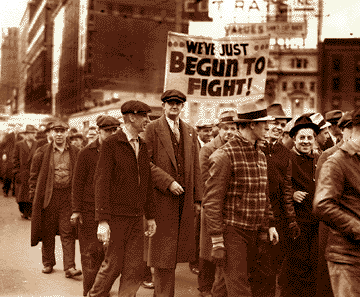 Union workers and sympathizers march toward a rally in Detroit's Cadillac Square in early 1937. The fledgling United Auto Workers were striking General Motors plants in Flint and other locations, and were encouraged when the Detroit rally drew 150,000 supporters.
Union workers and sympathizers march toward a rally in Detroit's Cadillac Square in early 1937. The fledgling United Auto Workers were striking General Motors plants in Flint and other locations, and were encouraged when the Detroit rally drew 150,000 supporters.





